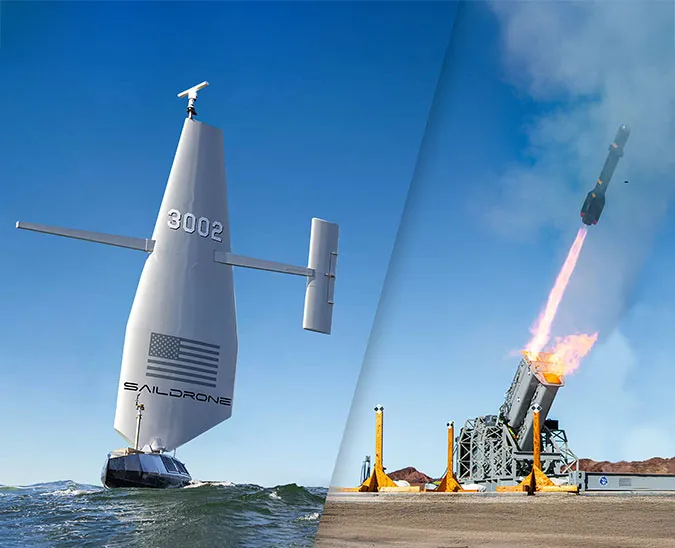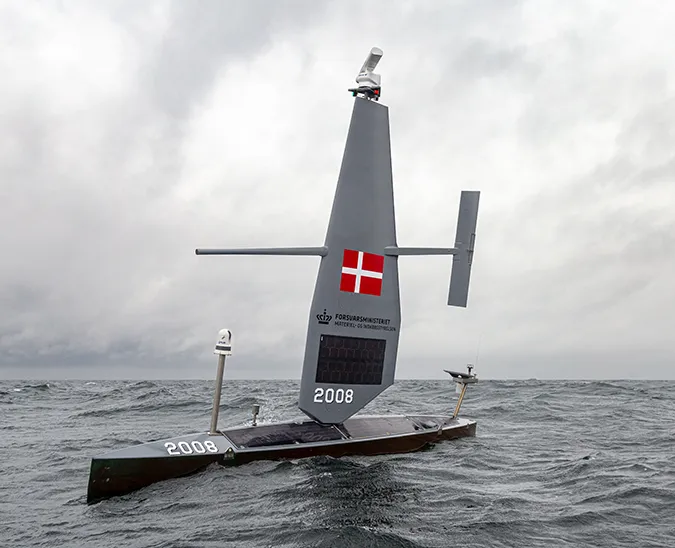Published on
Author
The 2019 Atlantic to Mediterranean (ATL2MED) mission is a public-private partnership between Saildrone and 12 oceanographic research institutions and universities from seven countries. Two Saildrone unmanned surface vehicles (USVs) were launched from the Canary Islands off the Northwestern Coast of Africa on October 18, 2019; the saildrones are first sailing south to the start of their mission in Cabo Verde, which they are expected to complete in the Italian city of Trieste on the Adriatic Sea in 2020. Throughout the 5,000 nautical mile (9,260 kilometers) mission, the saildrones will collect biogeochemical (pCO2, pH, dissolved oxygen, Chl-a), ecological (biomass/hydroacoustics), and physical measurements, as well as perform cross-calibrations at European Research Infrastructure (RI) sites.
ATL2MED consists of two phases. Phase 1 will focus on eddy surveys around Cabo Verde and is led by the Helmholtz Centre for Ocean Research (GEOMAR). Phase 2, led by Integrated Carbon Observation System, Ocean Thematic Center (ICOS OTC), will focus on CO2 measurements and cross-calibrations with European Research Infrastructure (RI), a series of ocean moorings managed by Spain, France, and Italy.
Throughout this ambitious mission, researchers from additional participating organizations will run regional missions, including comparisons with moorings, gliders, and other assets. These organizations include Ocean Science Centre Mindelo (OSCM), The Oceanic Platform of the Canary Islands (PLOCAN), Instituto Hidrográfico, Sorbonne University's Laboratoire Océanographique Villefranche (LOV), Le Centre Nationale de la Recherche Scientifique (CNRS), Istituto Nazionale di Oceanografia e Geofisica Sperimentale (OGS), Istituto di Scienze Marine del Consiglio Nazionale delle Ricerche (CNR-ISMAR), and Istituto sui Sistemi Intelligenti per l'Automazione del CNR (CNR-ISSIA).
SD 1030 and SD 1053 deployed from the Canary Islands will sail south to Cabo Verde to perform an eddy survey led by GEOMAR, and then north to Trieste, Italy, performing CO2 measurements and cross-calibrations with European Research Infrastructure (RI) throughout the duration of the mission.
The Saildrone USV platform was selected for the mission because of the large distances between observatories and the remoteness of some of the ocean carbon stations. Saildrone USVs are wind and solar-powered and designed to perform in the most challenging ocean conditions, from the Tropical Pacific to the high latitudes. Each vehicle carries a payload of science-grade instruments to collect oceanographic and meteorological data above and below the sea surface. In addition to the standard Saildrone sensor suite, one saildrone is equipped with an echo sounder (SD 1053) and the other is equipped with an ADCP and ASVCO2 sensor, a state-of-the-art pCO2 sensor developed by NOAA PMEL (SD 1030).
Mission objectives
The saildrones will begin the mission by performing an eddy survey, led by GEOMAR. The Canary Current Upwelling System (CanCS) off West Africa hosts one of the world’s most productive ecosystems. Fishing is the main source of income and sustenance for the local population, and the region is actively fished by both commercial and local fleets. But the area is also vulnerable to climate change through increasing sea temperatures, ocean acidification, and deoxygenation.

Eddies play an important role in the lateral mixing and transport of physical and biogeochemical properties in the ocean. A pilot study showed that eddies create dramatic effects on the sub-surface oxygen concentration, which leads to severe hypoxia and causes redox-dependent biogeochemical and biological responses. However, the impact of such extreme eddies on the local ecosystem and therefore on local fisheries remains unclear due to lack of systemic observations.
The Saildrone mission will guide a multifaceted, multicomponent field study on the different types of eddies and the role they play in the lateral transport of biogeochemical properties and biomass distribution in the CanCS.
“Saildrone USVs allow us to observe eddies in very high resolution and will provide a synoptic view of the eddies for the first time,” said Dr. Björn Fiedler of GEOMAR.

The cross-calibration of European RI sites and validation of carbon measurements will be led by Dr. Ingunn Skjelvan and Dr. Benjamin Pfiel of ICOS OTC. ICOS stations provide high-quality carbon measurements in the ocean, however, many other observational platforms are either not capable of high-quality data due to technical limitations or their dedication to other research priorities. The ocean observing system lacks a suitable method to reference carbon measurements from different observation networks to the ICOS stations.
The Saildrone platform will be used to interconnect nine observing stations in the Atlantic Ocean and Mediterranean, Ligurian, and Adriatic Seas: CVOO, ESTOC, LION, ANTARES, DYFAMED, W1M3A, E2M3A, PALOMA, and MIRAMARE. The data collected will be used to validate in situ measurements taken by the fixed ocean stations and enhance quality-control procedures.
“Mobile and cost-effective autonomous vehicles with multidisciplinary observation capacities could potentially facilitate a better integration of marine RIs in Europe,” said Pfiel.
The European Station for Time-Series in the Ocean at the Canary Islands (ESTOC) is the ocean time-series program reference for the Eastern Subtropical Gyre. In operation since 1994, it is located 60 nautical miles (111 kilometer) north of the Canary Islands in the transitional zone between the Northwest Africa coastal upwelling region and the open ocean oligotrophic waters of the Northeastern Atlantic Subtropical Gyre. Sustained monitoring by ocean observatories provides critical data and knowledge related water mass variability, increasing sea surface temperature, and eutrophication, as well as changes in ocean chemistry.

The ATL2MED mission will provide new monitoring perspectives and capabilities, which will allow PLOCAN to carry out both validations of the carbon measurements with other existing fixed-point and mobile observing platforms, as well as to improve ocean understanding at the mesoscale level, thereby increasing the sampling rate between existing observatories in the area of interest.
“Autonomous mobile platforms such as Saildrone offer unprecedented potential, and capabilities for a more efficient, cost-effective, and sustainable ocean observation,” said Dr. Carlos Barrera of Oceanic Platform of the Canary Islands (PLOCAN).
The saildrones will then transit autonomously through the famous Strait of Gibraltar, working closely with Instituto Hidrográfico of Portugal and PLOCAN of Spain.
When the saildrones reach Nice, they will stop to perform an intercomparison study of the Nice-Calvi glider line in partnership with the Laboratoire Oceanographique de Villefranche-sur-Mer (LOV). The saildrones will take continuous pCO2 measurements along an 85-nautical mile (157-kilometer) transect between Nice and Calvi on the island of Corsica. At the same time, a SeaExplorer glider equipped with a pCO2 sensor will take measurements in the upper 600 meters (1968.5 feet) of water. The two platforms will pass through the DYFAMED time series, where monthly carbonate sampling and hourly pCO2 measurements are taken. This will provide an opportunity to compare both pCO2 sensors (PMEL ASVCO2 vs. pro-Oceanus) and as well as to compare fixed-point measurements and in situ data.
“This mission will be the first opportunity to have 3D distribution of physical and biogeochemical variables from coastal to open ocean zones and to validate both approaches in terms of carbonate measurements,” said Dr. Laurent Coppola of LOV.

Once in Italy, the saildrones will focus on areas near the Aeolian Islands where there are natural CO2 seeps due to volcanic activity. This study will be led by the Istituto Nazionale di Oceanografia e Geofisica Sperimentale (OGS), and two institutes run by OGS: OGS European Carbon Dioxide Capture and Storage Laboratory Infrastructure (ECCSEL) and ECCSEL- NatLab-Italy at Panarea Island.
Currently, OGS has completed small-scale surveys in the area and would like to measure the CO2 changes from the sea surface to the atmosphere. OGS has measured areas both with pCO2 and pH along the water column, but no surface measurements have been taken. Once this portion of the mission is complete, the USVs will continue into the Adriatic to their ultimate destination of Trieste.
The ATL2MED mission represents Saildrone’s commitment to the power of the public-private partnership model. Saildrone and the participating research institutes are contributing to this mission through a combination of financial and in-kind contributions. ATL2MED is generously sponsored by PEAK6, a private technology and investment firm started by Jenny Just and Matt Hulsizer. PEAK6 began with a simple premise: to apply technology to make the options market operate more efficiently and, in the process, deliver superior investment results. More than two decades later, the firm invests in, owns, and starts businesses where it can apply its unique blend of technology and operational expertise to make industries and businesses perform better. By supporting the ATL2MED mission, PEAK6 seeks to catalyze world-class science, encouraging participants to think differently and use cutting-edge technology to accelerate new insights about our oceans that impact humanity.
The goal of the 2019 ATL2MED mission, as well as all missions conducted by Saildrone USVs, it not only to contribute to a greater understanding of the impacts on the ocean ecosystem, but also to develop a better understanding of the socio-economic impacts of acidification, deoxygenation, climate change, and ocean processes on communities reliant on the Atlantic and Mediterranean. This is the first step in what could become an annual time series of USV-collected data to further the various scientific objectives of the regional ocean observing community. Saildrone USVs make in situ data collection cost-effective at scale, contributing to a better understanding of the processes, ecosystems, and conditions that impact coastal communities in the Atlantic, Mediterranean, and beyond.
Resources
Oceanic Platform of the Canary Islands (PLOCAN), “Saildrone – ATL2MED International Scientific-Technological Mission Launched,” accessed October 24, 2019.





